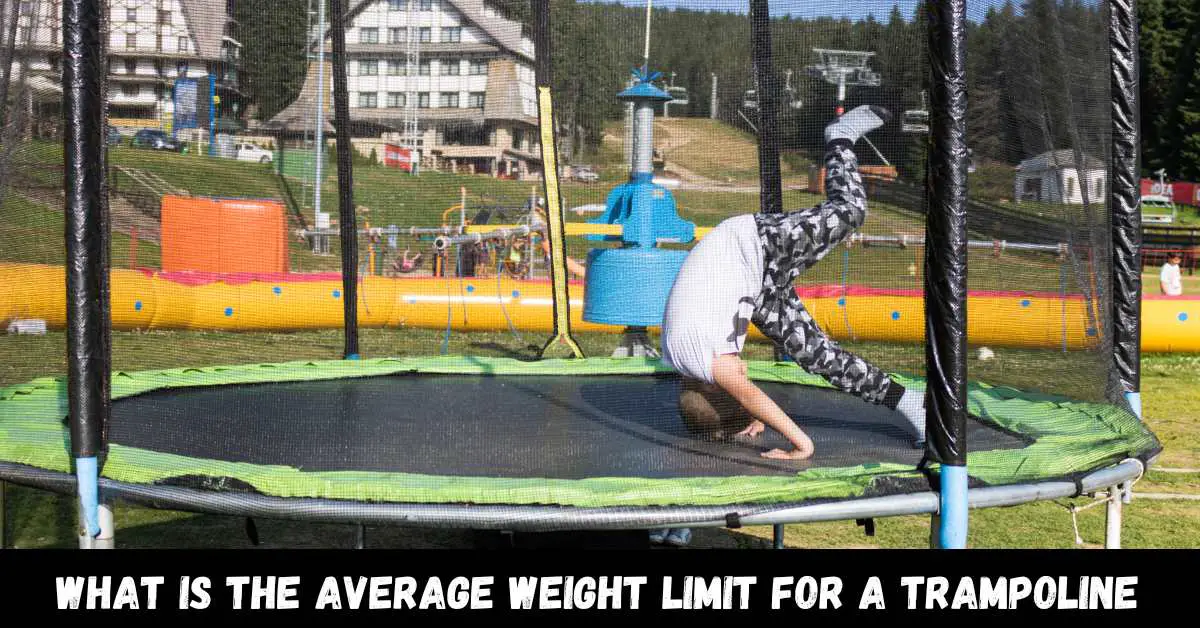Trampolines can be a fun and exciting way to get exercise, but it’s important to understand their weight limits. I know how exhilarating it can be to soar through the air. However, it’s crucial to be aware of the potential dangers of exceeding a trampoline’s weight limit.
What is the Average Weight Limit for a Trampoline? It’s essential to consider various factors such as the number of springs, the trampoline’s material, and whether it’s designed for indoor or outdoor use, all of which can impact the weight limit.
I urge anyone who plans to use a trampoline to follow the weight limit guidelines and practice proper safety precautions to ensure a fun and safe experience.
What is the Average Weight Limit for a Trampoline: The average weight limit for a trampoline ranges from 250 to 450 pounds, depending on the type and size of the trampoline. Factors like material and spring count can also affect weight limits.
Is the weight limit of a trampoline important?
It’s important to pay attention to the weight limit of a trampoline because we want to make sure our kids and ourselves are safe while jumping on it. If we use a trampoline that is too small for our weight, we may hit the ground and hurt ourselves.
Also, the trampoline legs may bend or break if we exceed the weight limit. The weight limit is also important because it determines how many people can jump together on the trampoline.
The weight limit depends on the materials used, the size, and the style of the trampoline. Overall, using a trampoline with the right weight limit is crucial to ensure a safe and enjoyable jumping experience for the whole family.
Trampoline Styles and Weight Limit:
Trampolines come in two main shapes: round and rectangular. Round trampolines are the most popular choice for families, while rectangular trampolines are used by both athletes and growing families.
Rectangular trampolines are typically stronger and can hold more weight than round trampolines because they are designed to handle higher impacts.
So, if you have an athlete in the family or expect to have multiple people jumping on the trampoline, a rectangular trampoline might be a better option.
Material Impact on Trampoline Weight Limit:

The springs, frame, and jumping mat are the main materials that determine a trampoline’s weight limit. A trampoline with more springs, especially high-quality ones, can handle more weight and provide a higher bounce.
This principle applies to trampolines with bungee cords instead of springs too. The frame of a trampoline is usually the strongest part and rarely breaks unless damaged, but it still plays a role in determining the weight limit.
A heavy-duty frame can support a larger weight limit than a lighter one. Finally, the jumping mat is also important. A heavy-duty mat can accommodate heavier users than a light one. All of these materials work together to determine the maximum weight limit of a trampoline.
Trampoline Size and Capacity:
The weight limit of a trampoline depends on its size. Generally, larger trampolines can handle more weight than smaller ones. So, if you need a trampoline that can support more people or heavier individuals, consider getting a larger size.
What is the significance of knowing the weight limit of your trampoline?
Trampolines have weight limits to keep users safe. If the combined weight of users on the trampoline exceeds the weight limit, it may not be able to support them, resulting in injury.
It’s important to know the weight limit of your trampoline before using it, especially if multiple people will be jumping on it. You can calculate the total weight of all users to make sure it doesn’t exceed the weight limit.
What are the weight limits for trampolines?
Trampoline weight limits are important for safety reasons. A trampoline that exceeds its weight limit may not provide enough space between the mat and the ground for safe landings, and the frame may buckle under overweight activities.
It’s also important to consider the weight limit if you want to invite more people to jump on the trampoline. The weight limit is determined by the materials, size, and style of the trampoline.
Having a trampoline with the right weight limit ensures safe and enjoyable jumping for you and your family.
How does exceeding the weight limits on a trampoline affect safety?
Exceeding the weight limit on a trampoline can result in some unsafe problems. Your trampoline may get damaged if you do overweight activities like jumping on it with too many people. The springs may no longer work properly, and holes may form in the trampoline mat.
There is also a higher chance of injury while jumping if you exceed the weight limit, which is the worst-case scenario that no one wants to experience.
However, these situations rarely happen if you make the right choice by following the weight limit guidelines. So it’s important to consider the weight limit when purchasing a trampoline to ensure your and your family’s safety while having fun.
What are some ways to increase the weight limit of a trampoline?

Once a trampoline is manufactured, it is difficult to increase its weight limit. Therefore, it is important to choose the right trampoline for you and your family before buying it. However, if you take good care of your trampoline, its weight limit may remain the same over time.
Here are some tips to help you take care of your trampoline:
- Look for trampolines with crack-resistant galvanized springs. This will help the springs last longer by protecting them from harsh weather like rain and wind.
- Regularly check the frame, springs, and jumping pad for any signs of wear and tear. If there are any issues, replace the springs or trampoline mat.
- Use a rain cover to protect your trampoline when it is not in use.
- Take care of your trampoline during the winter months by following proper winter care guidelines.
- Make sure your trampoline comes with a warranty.
How can I select the most suitable trampoline for me based on weight limit? A step-by-step guide?
Here are the steps to choose the best trampoline for you by weight limit:
- Determine who will use the trampoline, only kids or the whole family and friends.
- Calculate the maximum weight of all individuals who will use the trampoline. For example, if you’re purchasing it for your kids, measure their weight and add it up. If you’re getting it for the whole family, measure the weight of all family members and friends who may use it, and add it up.
- Once you get the final number, choose a trampoline that matches or exceeds the weight limit. It is always recommended to pick a trampoline with a higher weight limit than the final number you get. This is because children grow, and the weight limit may not be enough in the future.
- Consider purchasing a trampoline with a weight limit that can accommodate the heaviest user.
By following these simple steps, you can ensure that you select the right trampoline with the correct weight limit for your family’s needs.
Testing Trampoline Weight Limits
The American Society for Testing and Materials (ASTM) is an organization that sets standards for different products to ensure safety, including trampolines.
They have set a rule that a trampoline needs to be able to hold a weight that is four times the maximum weight limit set by the manufacturer.
For example, if a trampoline has a weight limit of 200 pounds, it must be able to hold a weight of 800 pounds during testing.
This is to make sure that the trampoline is safe and can handle unexpected loads or stress, such as if multiple people are jumping on it at the same time. However, not all trampoline manufacturers are required to pass these ASTM tests.
So it’s important to do some research and buy from a reputable brand that prioritizes safety. Skywalker is one such brand that runs its trampolines through these tests to ensure they meet high safety standards.
What is the Average Weight Limit for a Trampoline: Major Factors
The average weight limit for a trampoline can vary depending on several factors. Some of the major factors that can affect the weight limit of a trampoline are:
Spring System:
The bounciness of a trampoline comes from coiled springs that connect the jumping pad to the frame. The more springs a trampoline has, the higher the bouncing potential and weight limit.
However, it’s important to arrange the springs properly to make sure the trampoline can hold a heavier load.
The type of springs used on a trampoline is important for how much weight it can hold and how bouncy it is. Thicker and smaller springs usually mean a higher weight limit and better bouncing.
It’s also important to choose rust-resistant springs, so they don’t get weaker over time and affect the trampoline’s ability to hold weight.
Trampoline Shape:
The shape of a trampoline can affect its weight limit, which is the maximum weight that it can safely support. In general, rectangular trampolines have a higher weight limit than circular ones.
This is because the rectangular shape provides more stability and even distribution of weight. Oval trampolines also tend to have a higher weight limit than round trampolines due to their similar shape to rectangular trampolines.
Trampoline Size:
Trampolines come in different sizes, and the larger the size, the higher the weight limit it can hold. This is because larger trampolines have a bigger surface area and can distribute weight more evenly.
Older kids and adults are usually heavier than younger kids, so a trampoline that is meant for them needs to have a higher weight limit. For example, a 12-foot trampoline can typically hold around 250-300 pounds, while a 15-foot trampoline can handle up to 450 pounds.
Frame Construction:

The trampoline frame is the part of the trampoline that holds all the other components together, kind of like a skeleton. Most trampoline frames are made of metal, usually steel, but some frames are stronger than others depending on how they are constructed.
Frames made of thicker, rust-resistant steel are more stable, which makes them ideal for carrying heavier weights. These frames are also more durable and less likely to break, so they are a good choice for kids who might jump with more force.
Jumping Mat Material:
The material used to make the jumping mat is important in determining the weight limit of a trampoline. Usually, waterproof canvas or woven polypropylene is used because they are strong and durable.
The quality of the weaving is also important to prevent tearing or stretching when people bounce on the trampoline.
Average Weight Limit for Trampolines Based on Their Size and Shape
As previously mentioned, the weight capacity of a trampoline is determined by its shape and size, and the following are some general recommendations.
Trampoline Load Limits Based on Shape
Trampolines come in three different shapes – round, oval, and rectangular. Round trampolines can typically handle a weight of 200-400 pounds. On the other hand, oval and rectangular trampolines are much stronger and can handle up to 500 pounds.
The reason for this difference in weight capacity is because of how the springs are positioned and how they work. When you jump on a circular trampoline, the springs experience an equal amount of pressure, which can be a lot.
But with oval or rectangular trampolines, only some springs bend when you jump. This means that the pressure is distributed more evenly, which reduces stress on the springs and allows them to support more weight.
Trampoline Weight Limit by Size
- 12-ft trampolines can hold 250–300 lbs. and are suitable for kids in the middle childhood stage.
- 14-ft trampolines have a weight limit of 250–350 lbs. and are suitable for teenagers.
- Mini trampolines for toddlers have a weight limit of 100 lbs.
- Adult rebounder trampolines have a capacity of up to 600 lbs.
- The weight capacity of a trampoline must be higher than the actual weight of the user to prevent the trampoline from snapping.
- 8 to 10-ft trampolines designed for children aged 3 to 10 years old have a weight capacity of 75–150 lbs.
- 15 to 16-ft trampolines have a weight capacity of 250–450 lbs.
What is the Max Weight for a Trampoline: Importance
Knowing the maximum weight limit of a trampoline is important for safety reasons. Exceeding the weight limit can cause the trampoline to become unstable, increasing the risk of injury to the user.
The weight limit is determined based on the trampoline’s size, shape, frame, springs, and jumping mat, and it’s crucial to follow the manufacturer’s recommended weight limit to ensure the safe use of the trampoline.
Additionally, understanding the weight limit can help you choose the appropriate trampoline size and shape for your needs and ensure that it can accommodate all users safely.
Three Reasons Why Trampolines Have Weight Limits
Allow us to clarify why weight limits are crucial, even if our trampolines are some of the most durable and dependable ones in the market.
Longevity and Maintenance:

It’s disappointing if your trampoline breaks down after just a few years, and that’s not what you want. You want your trampoline to last for a long time, maybe even for a lifetime. That’s why it’s essential to know the average weight limit of a trampoline before purchasing it.
By taking good care of it and following the manufacturer’s instructions, you can ensure that it lasts longer and provides you with many days of fun.
Safety Standards and Guidelines:
The most important reason why trampolines have weight limits is for safety. Manufacturers provide these limits to protect users from getting hurt. It’s not safe to use a trampoline incorrectly, but it’s even more dangerous to exceed the weight limit.
So, before buying a trampoline, always check the weight limit set by the manufacturer, as it varies depending on the model. Don’t rely on information from blogs or other sources.
Compliance with Industry Standards and Warranties:
The third reason why weight limits are important for trampolines is to meet industry standards and warranties. When a manufacturer makes a trampoline, they have to follow certain rules and regulations to ensure that it is safe to use.
These rules require the manufacturer to inform buyers of the weight limit for the trampoline, which is why weight limits are included in the manual. This ensures that the trampoline meets the industry’s safety standards and comes with warranties.
Types of trampolines
There are several types of trampolines available on the market. Here are some of the most common ones:
Outdoor Trampolines:
As the name suggests, outdoor trampolines are designed for use outdoors, typically in a backyard or garden. These trampolines come in a variety of shapes and sizes, from circular to rectangular, and are usually built with weather-resistant materials to withstand exposure to the elements.
Outdoor trampolines often come with safety enclosures or nets to prevent users from falling off the trampoline and injuring themselves. These trampolines are popular among families and kids and can provide hours of fun and physical activity.
Indoor Trampolines:
Indoor trampolines are designed for use in indoor spaces, such as gyms, fitness centers, or even homes with large enough rooms or basements. These trampolines are typically smaller in size than outdoor trampolines and are often used for gymnastics, acrobatics, or other forms of athletic training.
Indoor trampolines are built with materials that are meant to be used indoors and are often foldable for easy storage.
Water Trampolines:
Water trampolines are specialized types of trampolines designed to be used on water bodies such as lakes, ponds, or swimming pools. These trampolines are typically inflatable and come in a variety of shapes and sizes, such as circular or rectangular.
Water trampolines are popular among families and kids as they provide a unique and fun way to play in the water.
Water trampolines are made of durable materials that can withstand exposure to water and the elements. They typically have a sturdy frame that is covered with a durable fabric, which is usually made of PVC or nylon.
The fabric is then attached to the frame using a series of ropes or straps. Inflatable water trampolines are also available, which are easy to set up and take down, and are perfect for those who want to take their trampoline to different locations.
Water trampolines are equipped with various safety features to ensure that users are safe while having fun. These features may include safety nets, anchor systems, and padding around the edges.
The safety nets are designed to prevent users from falling off the trampoline and into the water, while the anchor systems ensure that the trampoline stays in place even in choppy water. The padding around the edges helps to prevent injuries from accidental falls or bumps.
Mini Trampolines:
Mini trampolines also referred to as rebounders or fitness trampolines, are smaller versions of traditional outdoor trampolines designed for indoor use. They are typically round or oval in shape and range in size from 38 to 50 inches in diameter.
These trampolines are usually low to the ground and have shorter legs than regular trampolines, making them easier to store under a bed or in a closet.
Mini trampolines are primarily used for fitness or exercise purposes, as they provide an effective low-impact workout that can improve cardiovascular health, balance, and coordination.
They are also used for rehabilitation exercises, as the bouncing motion can help with joint pain and muscle strengthening.
The weight limit of mini trampolines is typically lower than that of regular trampolines, with most models supporting weights up to 200-300 lbs. It is important to adhere to the weight limit to ensure safety and prevent damage to the trampoline.
Rebounder Trampolines:
Rebounder trampolines are similar to mini trampolines in their design and usage, as they are also primarily used for fitness and exercise purposes.
The low-impact nature of rebounder trampoline workouts makes them an ideal choice for those seeking to improve their cardiovascular health, balance, and coordination without placing undue strain on their joints.
Like mini trampolines, rebounder trampolines are small in size and are therefore easily stored and transported. Additionally, rebounder trampolines typically have a weight limit of around 200-300 pounds, allowing for a wide range of users to engage in exercise on the equipment.
Overall, rebounder trampolines provide a convenient and effective way for individuals to incorporate fun and engaging exercise into their daily routines, while also reaping the physical benefits of low-impact workouts.
Fitness Trampolines:
Fitness trampolines are larger trampolines that are designed to meet the needs of people who wish to use them for fitness and exercise. They typically come with many features that are specifically geared towards fitness purposes.
Some of these features include adjustable handles, resistance bands, and bungee cords. Adjustable handles provide extra support and balance for users, especially for those who are just starting or have balance issues.
Resistance bands can be attached to the trampoline to provide an extra level of resistance to various exercises. Fitness trampolines are designed to offer a low-impact workout that is easier on the joints than running or other high-impact exercises.
Regular use of fitness trampolines can help improve cardiovascular health, increase muscle tone, and improve balance and coordination. They are a fun and efficient way to incorporate exercise into a daily routine.
Spring-Free Trampolines:
Spring-free trampolines are designed with safety in mind. They are built without traditional metal springs which can be a safety hazard for users, especially children.
Instead, these trampolines use alternative materials, such as fiberglass rods or bungee cords, to provide bounce. Spring-free trampolines come in various shapes and sizes and are often recommended for families with young children.
In-Ground Trampolines:
In-ground trampolines are installed on the ground, making them a permanent fixture in a backyard or garden. These trampolines are often preferred by those who want a trampoline that is not an eyesore in their backyard.
In-ground trampolines come in various shapes and sizes and are often built with safety features, such as a safety net or pad, to prevent injuries.
Round trampolines
Round trampolines are the most popular type of trampolines available in various sizes ranging from mini-trampolines to large outdoor trampolines. These trampolines are supported by several springs that run around the frame and attach to the mat, creating a circular bouncing surface.
The circular shape of round trampolines makes them suitable for recreational bouncing and ideal for families with young children.
Round trampolines are also considered to be safer than other shapes due to their design, which directs jumpers toward the center of the trampoline.
They also provide a larger jumping surface area than other trampoline shapes, allowing for more than one person to bounce at the same time.
In addition, round trampolines are easy to assemble and disassemble and can be used both indoors and outdoors, making them a versatile option for all types of spaces.
Overall, round trampolines are an excellent choice for families looking for a fun and safe way to enjoy bouncing and jumping activities.
Rectangular trampolines
Rectangular trampolines are specifically designed for advanced bouncing and training purposes. They are commonly used by gymnasts and athletes who require more control over their bouncing surfaces.
Unlike round trampolines, rectangular trampolines provide a more consistent and predictable bounce. This makes them ideal for performing tricks and stunts, as the user can maintain their balance and control throughout the entire bounce.
Due to their rectangular shape, these trampolines are also great for those with limited backyard space, as they can be positioned closer to walls and fences without compromising on the size of the jumping surface.
Rectangular trampolines are typically larger than round trampolines and have a higher weight limit, making them more suitable for older children and adults. Additionally, they have a stronger frame and are generally more durable than their round counterparts, allowing for longer-lasting use.
Oval trampolines
Oval trampolines are a hybrid of round and rectangular trampolines, offering a combination of a consistent and controlled bounce with a larger jumping area. They are a great option for families looking for a spacious bouncing surface.
Oval trampolines are also suitable for older kids and adults who want to have a fun and challenging workout.
Compared to round trampolines, oval trampolines have a higher weight limit and can accommodate more users at a time. They also offer a more even and predictable bounce due to their shape and spring configuration.
This makes them ideal for those who want to practice advanced tricks and stunts. Additionally, oval trampolines often come with safety features such as enclosure nets and padded frames to prevent injuries and ensure a safe bouncing experience for everyone.
Safety Considerations
Trampolines can be a fun and exciting way to stay active, but it’s important to take proper safety precautions to avoid injury. Here are some important safety considerations to keep in mind:
Importance of following weight limits:
The weight limit on a trampoline is one of the most important safety considerations. Manufacturers provide weight limits for a reason; to protect users.
Exceeding weight limits can lead to serious injuries and even death. Therefore, before purchasing a trampoline, make sure to check the weight limit guidelines provided by the manufacturer and abide by them strictly.
Risks associated with exceeding weight limits:
When the weight limit on a trampoline is exceeded, the risk of injury increases significantly. The extra weight causes the trampoline mat and springs to stretch beyond their normal capacity, putting excessive pressure on the frame and causing it to bend or break.
This can result in serious injuries to the user or anyone in the vicinity.
Importance of proper assembly and maintenance:
Proper assembly and maintenance of a trampoline are crucial to ensure its safety. Trampolines should always be assembled according to the manufacturer’s instructions and guidelines. Any loose or missing parts should be replaced immediately.
Maintenance of the trampoline should include regular checks of the frame, springs, mat, and safety net to ensure they are in good condition. In addition, trampolines should be kept free of debris, and users should be instructed on how to use the trampoline safely to avoid injuries.
FAQs:
Q:1 What is the average weight limit for a trampoline?
The average weight limit for a trampoline is around 250 pounds. However, weight limits vary depending on the size and type of trampoline, so it is important to check the manufacturer’s guidelines before purchasing a trampoline.
Q:2 Can a trampoline hold more weight than its weight limit?
No, it is not safe to exceed the weight limit of a trampoline. Doing so can put unnecessary strain on the trampoline’s frame, springs, and mat, which can cause them to break and potentially injure the user.
Q:3 Can multiple people use a trampoline at the same time?
Most trampolines are designed for single-person use only. Attempting to have multiple people use the trampoline simultaneously can cause the weight limit to be exceeded and increase the risk of injury.
Q:4 What happens if the weight limit of a trampoline is exceeded?
If the weight limit of a trampoline is exceeded, the trampoline may break, which can lead to serious injury. Exceeding the weight limit can cause the springs to snap, the frame to bend or break, or the mat to tear, which can cause the user to fall off the trampoline.
Q:5 Can children use trampolines with high weight limits?
Trampolines with high weight limits are designed for heavier users but can still be used by children as long as they are supervised by an adult. It is important to ensure that children follow all safety guidelines, such as not attempting flips or somersaults, to prevent injury.
Q:6 Is there a weight limit for mini trampolines?
Yes, even mini trampolines have weight limits. The weight limit for a mini trampoline is typically around 100 pounds, but it is important to check the manufacturer’s guidelines before use.
Q:7 How do I know if a trampoline is safe for me to use?
To ensure a trampoline is safe for use, check that it meets industry safety standards, such as those set by ASTM or CE. Also, check the manufacturer’s guidelines for weight limits and other safety guidelines, and make sure the trampoline is properly assembled and maintained.
Always follow safety guidelines and supervise children when using a trampoline.
Conclusion:
In conclusion, understanding the weight limit of a trampoline is crucial for ensuring safety and durability. It is important to note that weight limits vary depending on the size and type of trampoline, and exceeding the limit can lead to serious injuries or damage to the trampoline.
As a general guideline, mini trampolines for toddlers have a weight limit of 100 lbs, while adult rebounder trampolines can hold up to 600 lbs.
Manufacturers provide weight limits for a reason – to protect users from potential safety hazards. It is essential to follow the manufacturer’s guidelines for weight limits and other safety considerations, including proper assembly and maintenance, to prevent accidents and prolong the life of the trampoline.
Before purchasing a trampoline, it is important to research and choose a reputable manufacturer that meets industry safety standards and provides clear weight limit guidelines.
By understanding and adhering to weight limits, trampoline owners can safely enjoy this fun and engaging activity with family and friends for years to come.
We hope you will be well aware about what is the average weight limit for a trampoline, after reading this comprehensive article. If you have any questions, feel free to comment below!

